Identifying periphery biomarkers of first-episode drug-naïve patients with schizophrenia using machine-learning-based strategies
IF 5.3
2区 医学
Q1 CLINICAL NEUROLOGY
Progress in Neuro-Psychopharmacology & Biological Psychiatry
Pub Date : 2025-02-25
DOI:10.1016/j.pnpbp.2025.111302
引用次数: 0
Abstract
Schizophrenia is a complex mental disorder. Accurate diagnosis and classification of schizophrenia has always been a major challenge in clinic due to the lack of biomarkers. Therefore, identifying molecular biomarkers, particularly in the peripheral blood, is of great significance. This study aimed to identify immune-related molecular biomarkers of schizophrenia in peripheral blood. Eighty-four Peripheral blood leukocytes of first-episode drug-naïve (FEDN) patients with schizophrenia and 97 healthy controls were collected and examined using high-throughput RNA-sequencing. Differentially-expressed genes (DEGs) were analysed. Weighted correlation network analysis (WGCNA) was employed to identify schizophrenia-associated module genes. The CIBERSORT algorithm was adopted to analyse immune cell proportions. Then, machine-learning algorithms including random forest, LASSO, and SVM-RFE were employed to screen immune-related predictive genes of schizophrenia. The RNA-seq analyses revealed 734 DEGs. Further machine-learning-based bioinformatic analyses screened out three immune-related predictive genes of schizophrenia (FOSB, NUP43, and H3C1), all of which were correlated with neutrophils and natural killer cells resting. Lastly, external GEO datasets were used to verify the performance of the machine-learning models with these predictive genes. In conclusion, by analysing the peripheral mRNA expression profiles of FEDN patients with schizophrenia, this study identified three predictive genes that could be potential molecular biomarkers for schizophrenia.
使用基于机器学习的策略识别首发drug-naïve精神分裂症患者的外围生物标志物
精神分裂症是一种复杂的精神障碍。由于缺乏生物标志物,精神分裂症的准确诊断和分类一直是临床面临的主要挑战。因此,识别分子生物标志物,特别是外周血中的分子生物标志物具有重要意义。本研究旨在鉴定外周血中精神分裂症的免疫相关分子生物标志物。采用高通量rna测序技术对首发drug-naïve (FEDN)精神分裂症患者84例外周血白细胞和97例健康对照进行检测。分析差异表达基因(DEGs)。采用加权相关网络分析(WGCNA)鉴定精神分裂症相关模块基因。采用CIBERSORT算法对免疫细胞比例进行分析。然后,采用随机森林、LASSO和SVM-RFE等机器学习算法筛选精神分裂症免疫相关预测基因。RNA-seq分析显示734个deg。进一步的基于机器学习的生物信息学分析筛选出了精神分裂症的三个免疫相关预测基因(FOSB, NUP43和H3C1),所有这些基因都与中性粒细胞和自然杀伤细胞休息相关。最后,使用外部GEO数据集验证带有这些预测基因的机器学习模型的性能。总之,通过分析FEDN患者的外周mRNA表达谱,本研究确定了三个可能成为精神分裂症潜在分子生物标志物的预测基因。
本文章由计算机程序翻译,如有差异,请以英文原文为准。
求助全文
约1分钟内获得全文
求助全文
来源期刊
CiteScore
12.00
自引率
1.80%
发文量
153
审稿时长
56 days
期刊介绍:
Progress in Neuro-Psychopharmacology & Biological Psychiatry is an international and multidisciplinary journal which aims to ensure the rapid publication of authoritative reviews and research papers dealing with experimental and clinical aspects of neuro-psychopharmacology and biological psychiatry. Issues of the journal are regularly devoted wholly in or in part to a topical subject.
Progress in Neuro-Psychopharmacology & Biological Psychiatry does not publish work on the actions of biological extracts unless the pharmacological active molecular substrate and/or specific receptor binding properties of the extract compounds are elucidated.

 求助内容:
求助内容: 应助结果提醒方式:
应助结果提醒方式:


